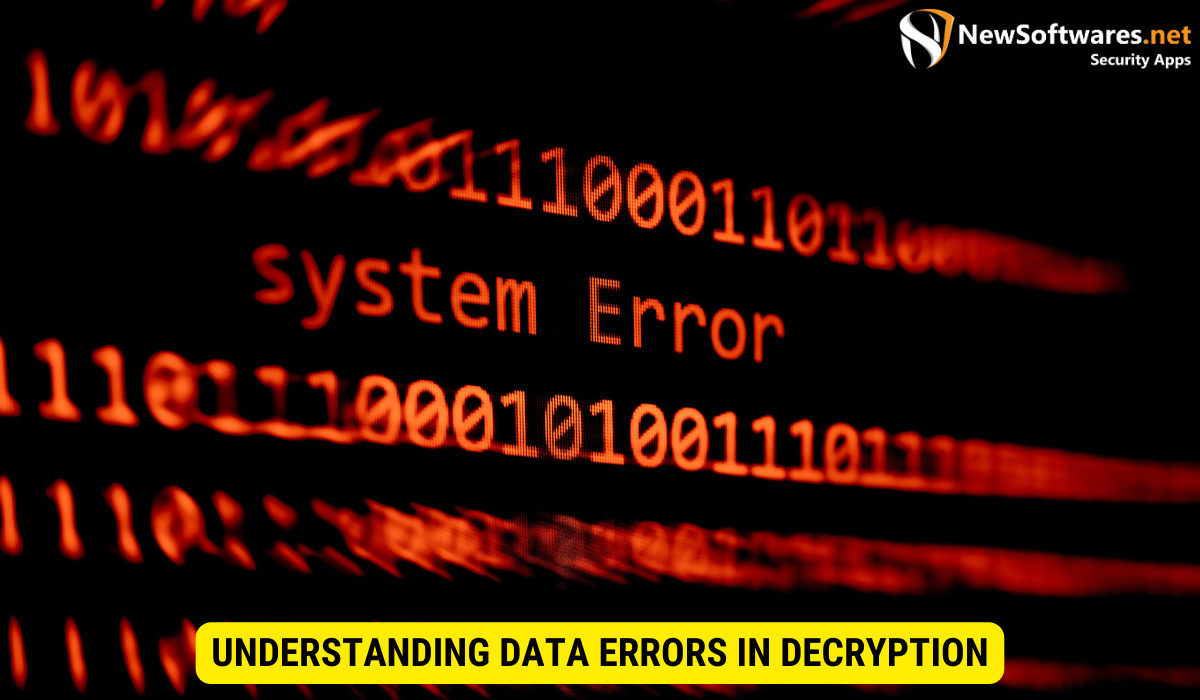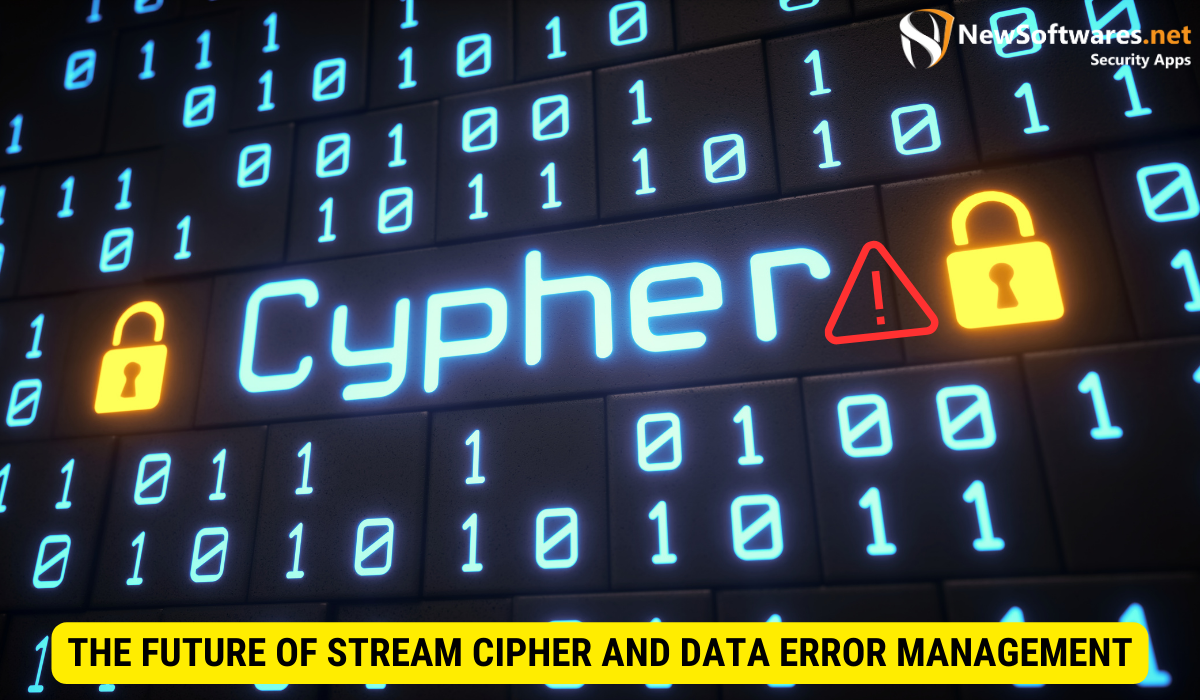Data errors during decryption can disrupt the synchronization between stream ciphers and ciphertext, potentially compromising data integrity and security.
Data errors can significantly impact the decrypted ciphertext in stream cipher encryption. Understanding how data errors occur during decryption and their role in cryptography is crucial to ensuring the security and integrity of sensitive data. This article explores the connection between data errors and stream cipher and the challenges of handling data errors in this context. It offers insights into the future of stream cipher and data error management.
Understanding Data Errors in Decryption

When it comes to decryption, data errors refer to any unintended alterations or corruptions that occur while converting ciphertext back to plaintext. These errors can be caused by various factors, including transmission problems, noise, hardware failures, or even intentional attacks by malicious actors.
Decrypting encrypted data is critical in ensuring the confidentiality and integrity of sensitive information. However, this process is not without its challenges. Data errors can occur during decryption, leading to potential issues and vulnerabilities in the decrypted plaintext.
Defining Data Errors in Cryptography
Within the realm of cryptography, data errors encompass both bit errors and burst errors. Bit errors involve the flipping of individual bits, which can corrupt specific characters or symbols in the decrypted plaintext. Burst errors, on the other hand, occur when a cluster of consecutive bits is affected, impacting larger portions of the decrypted data.
Bit errors can occur for various reasons, such as electromagnetic interference, faulty hardware components, or even cosmic radiation. These errors can be random and unpredictable, making detecting and correcting them challenging during the decryption process.
Burst errors, on the other hand, can be caused by factors like signal attenuation, multipath propagation, or interference from other devices. These errors can significantly impact the decrypted data, potentially leading to the loss or corruption of entire sections of the plaintext.
The Role of Data Errors in Decryption
Data errors in decryption can have wide-ranging consequences. Sometimes, even a single-bit error can render an entire decrypted data block useless or introduce significant inaccuracies. Imagine the implications if a critical piece of information, such as a financial transaction or a medical record, is corrupted due to a data error during decryption.
Data errors can be particularly problematic when it comes to stream ciphers, which encrypt data bit by bit using a keystream generated from a key. A single-bit error in the decrypted plaintext can cause a ripple effect, propagating and impacting subsequent bits. This cascade effect can severely compromise the integrity and reliability of the decrypted ciphertext, potentially leading to incorrect interpretations or actions based on the decrypted information.
Cryptographic systems must incorporate error detection and correction mechanisms to mitigate the impact of data errors during decryption. Techniques such as checksums, error-correcting codes, and redundancy checks can help identify and rectify errors, ensuring the accuracy and reliability of the decrypted plaintext.
Furthermore, cryptographic protocols and algorithms must consider the possibility of intentional attacks that introduce data errors during decryption. Adversaries may attempt to manipulate the decrypted data to gain unauthorized access, modify sensitive information, or disrupt the normal functioning of a system. Robust security measures, including authentication, integrity checks, and encryption key management, play a vital role in safeguarding against such attacks.
In conclusion, understanding data errors in decryption is crucial for ensuring the reliability and security of sensitive information. By recognizing the types of errors that can occur and implementing appropriate error detection and correction mechanisms, cryptographic systems can mitigate the risks associated with data errors and maintain the integrity of the decrypted plaintext.
Stream Cipher: An Overview
Stream ciphers are symmetric key encryption algorithms operating on individual bits or bytes of data. Unlike block ciphers, which encrypt fixed-size blocks of plaintext, stream ciphers encrypt data one bit or byte at a time, using a keystream generated from a secret key. This keystream is combined with the plaintext data using the XOR operation to produce the ciphertext.
The Basics of Stream Cipher
Stream ciphers are known for their simplicity and efficiency, making them suitable for real-time data encryption applications. The keystream in a stream cipher is typically generated by a pseudorandom number generator (PRNG), which requires a secret key as input. The PRNG produces a sequence of bits or bytes combined with the plaintext to generate the ciphertext.
The Importance of Stream Cipher in Data Security
Stream cipher algorithms are vital in ensuring data confidentiality, especially in scenarios where real-time communication and fast encryption/decryption performance are essential. Their simplicity allows for rapid encryption and decryption processes, making them particularly useful for secure communication protocols or disk encryption applications.
Data Errors and Stream Cipher: The Connection
There is an intimate connection between data errors and stream cipher encryption. While stream ciphers are inherently resistant to random bit errors, they can become vulnerable to data errors during decryption. The impact of data errors on a stream cipher’s ability to accurately decrypt ciphertext can have severe implications for data integrity and security.
How Data Errors Affect Stream Cipher?
Data errors during decryption can disrupt the synchronization between the stream cipher’s keystream and the ciphertext, leading to incorrect decryption results. Suppose a data error affects a single bit in the ciphertext. In that case, it can result in the incorrect bit being flipped during decryption, leading to the corruption of the corresponding bit in the plaintext. Moreover, burst errors can propagate through the decryption process, affecting subsequent bits and introducing additional errors.
The Consequences of Data Errors on Stream Cipher
The consequences of data errors on a stream cipher’s decrypted ciphertext can be far-reaching. The errors can lead to the loss or corruption of critical data, compromise the integrity of the decrypted information, or even render the entire decryption process ineffective. In scenarios where data errors go undetected, the resulting inaccuracies can have serious implications, especially in sensitive applications where the decrypted plaintext serves as the basis for critical decision-making processes.
Challenges in Handling Data Errors in Stream Cipher
Effectively handling data errors in stream cipher decryption poses significant challenges. These challenges revolve around identifying and mitigating the impact of errors, ensuring the decrypted data’s accuracy and integrity, and developing robust mechanisms for error detection and correction.
Identifying the Challenges
One of the main challenges in handling data errors in stream cipher decryption is detecting errors. Since stream ciphers operate on individual bits or bytes, even a single erroneous bit can result in incorrect decryption. Additionally, burst errors can be challenging to identify and correct, especially if the encryption process does not provide built-in error detection and correction mechanisms.
Overcoming the Challenges: Possible Solutions
Several approaches can be employed to overcome the challenges associated with data errors in stream cipher decryption. Implementing error detection and correction codes, such as cyclic redundancy checks (CRC) or forward error correction (FEC), can help identify and mitigate errors during decryption. Moreover, techniques like interleaving, which reorganizes the ciphertext to spread burst errors across multiple blocks, can aid in minimizing the impact of burst errors.
The Future of Stream Cipher and Data Error Management

As technology evolves and data security becomes an increasingly paramount concern, stream cipher algorithms and their ability to handle data errors will play a crucial role in safeguarding sensitive information.
Predicting the Future Challenges
While stream ciphers have proven effective in many applications, challenges remain. Future technological advancements may introduce new threats that stream cipher algorithms must address, such as more sophisticated attacks or vulnerabilities in the underlying cryptographic primitives. Additionally, the proliferation of high-speed networks and the rapid growth of data volumes will require stream ciphers to adapt and provide efficient and reliable data error management mechanisms.
Innovations and Improvements in Stream Cipher Technology
The future of stream cipher and data error management will likely involve innovations and improvements in cryptographic techniques. This may include the development of more robust error detection and correction mechanisms, integrating advanced error-resilient coding schemes, and exploring alternative approaches to stream cipher encryption that can better handle data errors without sacrificing performance.
Key Takeaways
- Data errors in decryption can significantly impact the decrypted ciphertext in stream cipher encryption, compromising data integrity and security.
- Stream ciphers encrypt data bit by bit using a keystream generated from a secret key, making them efficient for real-time encryption/decryption.
- Data errors during decryption can disrupt the synchronization between the stream cipher’s keystream and the ciphertext, leading to incorrect decryption results.
- Handling data errors in stream cipher decryption poses challenges, including error detection, correction, and minimizing the impact of burst errors.
- The future of stream cipher and data error management will involve advancements in cryptographic techniques to address emerging threats and ensure reliable data integrity.
FAQs
What are data errors in decryption?
Data errors in decryption refer to unintended alterations or corruptions while converting ciphertext back to plaintext. These errors can result from transmission problems, noise, hardware failures, or intentional attacks.
How do data errors affect stream cipher?
Data errors during decryption can disrupt the synchronization between the stream cipher’s keystream and the ciphertext, leading to incorrect decryption results. This can compromise data integrity and introduce inaccuracies in the decrypted plaintext.
What challenges are associated with handling data errors in stream cipher decryption?
Handling data errors in stream cipher decryption poses challenges in error detection and correction, identifying burst errors, and minimizing their impact. Ensuring the accuracy and integrity of the decrypted data is paramount.
What are possible solutions for handling data errors in stream cipher decryption?
Possible solutions for handling data errors in stream cipher decryption include implementing error detection and correction codes, such as cyclic redundancy checks (CRC) or forward error correction (FEC), and techniques like interleaving to spread burst errors across multiple blocks.
What does the future hold for stream cipher and data error management?
The future of stream cipher and data error management will likely include advancements in cryptographic techniques, such as improved error detection and correction mechanisms and alternative approaches to stream cipher encryption.
Conclusion
Data errors can significantly impact the decrypted ciphertext in stream cipher encryption, posing data integrity and security challenges. Understanding the connection between data errors and stream cipher and the challenges involved in handling such errors is crucial for designing robust encryption/decryption systems. Future advancements in stream cipher technology will ensure efficient and reliable data error management, safeguarding sensitive information in an increasingly digitized world.
